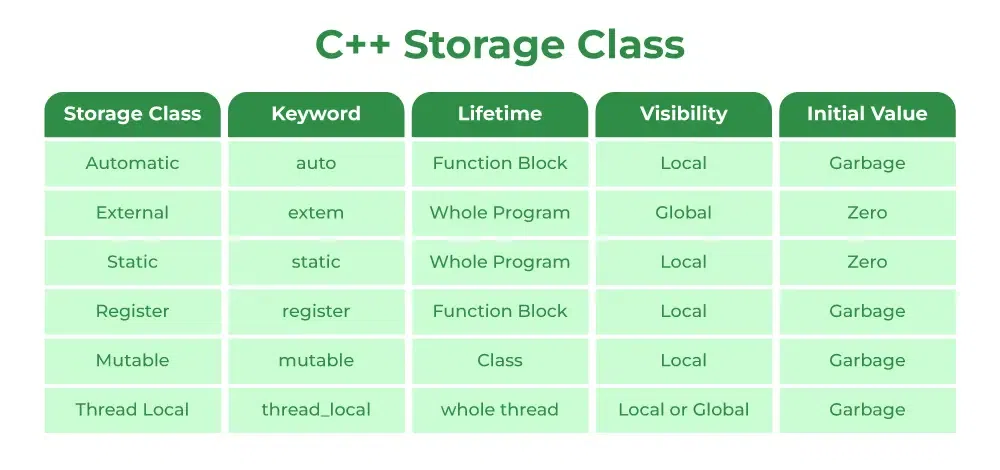C++ 存储类及示例¶
C++ 存储类 用于描述变量/函数的特性。它决定了变量的生命周期、可见性、默认值和存储位置,帮助我们在程序运行时跟踪特定变量的存在。存储类说明符用于指定变量的存储类。
语法¶
要指定变量的存储类,需遵循以下语法:
- C++ 使用 6 种存储类,如下所示:
- auto 存储类
- register 存储类
- extern 存储类
- static 存储类
- mutable 存储类
- thread_local 存储类

Below is a detailed explanation of each storage class:
以下是每种存储类的详细解释:
1. auto 存储类¶
auto 存储类 是在代码块内声明的所有变量的默认存储类。auto 表示自动,所有在代码块内声明的局部变量自动属于此类。
auto 存储类对象的特性¶
- 作用域: 局部
- 默认值: 垃圾值
- 内存位置: RAM
- 生命周期: 直到作用域结束
auto 存储类示例¶
C++
// C++ 程序演示 auto 存储类
#include <iostream>
using namespace std;
void autoStorageClass()
{
cout << "Demonstrating auto class\n";
// 声明一个 auto 变量
int a = 32;
float b = 3.2;
char* c = "GeeksforGeeks";
char d = 'G';
// 打印 auto 变量
cout << a << " \n";
cout << b << " \n";
cout << c << " \n";
cout << d << " \n";
}
int main()
{
// 演示 auto 存储类
autoStorageClass();
return 0;
}
输出
注意: 在早期的 C++ 中,我们可以使用
auto关键字显式声明 auto 变量,但从 C++11 起,auto关键字的含义发生了变化,不能再用于定义 auto 变量。
2. extern 存储类¶
extern 存储类 简单地告诉我们该变量在其他地方定义,而不是在使用它的同一个块内(即外部链接)。基本上,它的值在不同的块中分配,也可以在不同的块中被覆盖/修改。extern 变量实际上是一个全局变量,在声明时初始化了合法的值,以便在其他地方使用。
普通的全局变量也可以通过在任何函数/块中的声明/定义前加上 extern 关键字来变成 extern。使用 extern 变量的主要目的是它们可以在大型程序的不同文件之间访问。
extern 存储类对象的特性¶
- 作用域: 全局
- 默认值: 零
- 内存位置: RAM
- 生命周期: 直到程序结束
extern 存储类示例¶
C++
// C++ 程序演示 extern 存储类
#include <iostream>
using namespace std;
// 声明一个变量,使其成为 extern,初始值可以
// 也可以初始化为 x
int x;
void externStorageClass()
{
cout << "Demonstrating extern class\n";
// 告诉编译器变量 x 是一个 extern 变量
// 并且已在其他地方定义(main 函数之前)
extern int x;
// 打印 extern 变量 'x'
cout << "Value of the variable 'x'"
<< " declared as extern: " << x << "\n";
// 修改 extern 变量 x 的值
x = 2;
// 打印修改后的 extern 变量 'x'
cout << "Modified value of the variable 'x'"
<< " declared as extern: \n"
<< x;
}
int main()
{
// 演示 extern 存储类
externStorageClass();
return 0;
}
输出
Demonstrating extern class
Value of the variable 'x' declared as extern: 0
Modified value of the variable 'x' declared as extern:
2
有关 extern 变量的更多信息,请查看 链接。
3. static 存储类¶
static 存储类 用于声明静态变量,这些变量在 C++ 编程中广泛使用。静态变量具有在其作用域结束后仍保持其值的特性!因此,静态变量保留其上次使用的值。
我们可以说,静态变量只初始化一次,并且存在直到程序终止。因此,不会分配新的内存,因为它们不会被重新声明。全局静态变量可以在程序的任何地方访问。
static 存储类对象的特性¶
- 作用域: 局部
- 默认值: 零
- 内存位置: RAM
- 生命周期: 直到程序结束
注意: 全局静态变量可以在任何函数中访问。
static 存储类示例¶
C++
// C++ 程序演示 static 存储类
#include <iostream>
using namespace std;
// 包含静态变量的函数
// 在执行期间内存被保留
int staticFun()
{
cout << "For static variables: ";
static int count = 0;
count++;
return count;
}
// 包含非静态变量的函数
// 内存被销毁
int nonStaticFun()
{
cout << "For Non-Static variables: ";
int count = 0;
count++;
return count;
}
int main()
{
// 调用静态部分
cout << staticFun() << "\n";
cout << staticFun() << "\n";
// 调用非静态部分
cout << nonStaticFun() << "\n";
cout << nonStaticFun() << "\n";
return 0;
}
输出
For static variables: 1
For static variables: 2
For Non-Static variables: 1
For Non-Static variables: 1
4. register 存储类¶
register 存储类 使用 register 关键字声明寄存器变量,功能与 auto 变量相同。唯一的区别是,编译器会尽量将这些变量存储在微处理器的寄存器中(如果有空闲寄存器)。这使得寄存器变量的使用速度比存储在内存中的变量要快得多。如果没有空闲寄存器,这些变量将存储在内存中。
一个重要的注意点是,我们不能使用指针获取寄存器变量的地址。
register 存储类对象的特性¶
- 作用域: 局部
- 默认值: 垃圾值
- 内存位置: CPU 寄存器或 RAM
- 生命周期: 直到作用域结束
register 存储类示例¶
C++
// C++ 程序演示寄存器变量的使用
#include <iostream>
using namespace std;
void registerStorageClass()
{
cout << "Demonstrating register class\n";
// 声明一个寄存器变量
register char b = 'G';
// 打印寄存器变量 'b'
cout << "Value of the variable 'b'"
<< " declared as register: " << b;
}
int main()
{
// 演示 register 存储类
registerStorageClass();
return 0;
}
输出
注意: 从 C++17 起,
register关键字已被弃用。
5. mutable 存储类¶
有时需要通过 const 函数修改类/结构体中的一个或多个数据成员,即使你不希望函数更新类/结构体的其他成员。这可以通过使用 mutable 关键字轻松实现。mutable 关键字主要用于允许 const 对象的特定数据成员被修改。
当我们将函数声明为 const 时,传递给函数的指针变为 const。为变量添加 mutable 允许 const 指针修改成员。
mutable 存储类的特性¶
mutable 说明符不影响对象的链接性或生命周期。它与在该位置声明的普通对象相同。
mutable 存储类示例¶
C++
// C++ 程序演示 mutable 存储类说明符的使用
#include <iostream>
using std::cout;
class Test {
public:
int x;
// 定义 mutable 变量 y
// 现在它可以被修改
mutable int y;
Test()
{
x = 4;
y = 10;
}
};
int main()
{
// t1 被设置为常量
const Test t1;
// 尝试改变值
t1.y = 20;
cout << t1.y;
// 取消注释以下行
// 将会报错
// t1.x = 8;
// cout << t1.x;
return 0;
}
输出
6. thread_local 存储类¶
thread_local 存储类是 C++11 中新增的存储类。我们可以使用 thread_local 存储类说明符将对象定义为线程本地。thread_local 变量可以与其他存储说明符(如 static 或 extern)组合使用,thread_local 对象的属性会相应地变化。
thread_local 存储类的特性¶
- 内存位置: RAM
- 生命周期: 直到线程结束
thread_local 存储类示例¶
C++
// C++ 程序演示使用 thread_local 存储说明符
#include <iostream>
#include <mutex>
#include <thread>
using namespace std;
// 定义线程本地变量
thread_local int value = 10;
// 用于同步的互斥锁
mutex mtx;
int main()
{
// 创建 3 个线程
// 在线程 1 中修改值
thread th1([]() {
value += 18;
lock_guard<mutex> lock(mtx);
cout << "Thread 1 value: " << value << '\n';
});
thread th2([]() {
// 在线程 2 中修改值
value += 7;
lock_guard<mutex> lock(mtx);
cout << "Thread 2 value: " << value << '\n';
});
thread th3([]() {
// 在线程 3 中修改值
value += 13;
lock_guard<mutex> lock(mtx);
cout << "Thread 3 value: " << value << '\n';
});
// 等待所有线程完成
th1.join();
th2.join();
th3.join();
// 打印主线程中的 value 值
cout << "Main thread value: " << value << '\n';
return 0;
}
Output
如我们所见,每个线程都有自己的 thread_local 变量副本,并且只分配了其调用中指定的值。